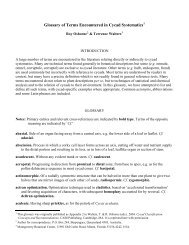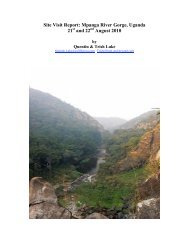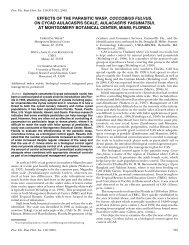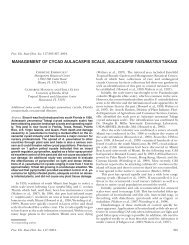Cycas-circinalis-cas.. - Cycad Specialist Group
Cycas-circinalis-cas.. - Cycad Specialist Group
Cycas-circinalis-cas.. - Cycad Specialist Group
Create successful ePaper yourself
Turn your PDF publications into a flip-book with our unique Google optimized e-Paper software.
3) Assess the impacts of harvest on C. <strong>circinalis</strong> populations by comparing the<br />
size and age structure of populations subject to different types of harvest<br />
4) Based on the above information, assess the conservation status of C. <strong>circinalis</strong><br />
in the Nilgiris Biosphere Reserve.<br />
2.0. Study Species<br />
C. <strong>circinalis</strong> is endemic to South India, where is it restricted to the Western Ghats<br />
and hilly regions of the southern peninsula, in the states of Kerala, Karnataka, Tamil<br />
Nadu, and the south of Maharashtra (Hill 1995). It is arborescent, growing up to 5 m tall,<br />
with bipinnate leaves that are about 150-200 cm long. The male individuals produce<br />
orange pollen cones, about 45 cm long. Seeds are yellow or red globose up to 4 cm long.<br />
C. <strong>circinalis</strong> is usually found fairly dense, seasonally dry scrubby woodlands in hilly<br />
areas.<br />
2.1. Study Site<br />
The Nilgiri Biosphere Reserve (NBR) is part of the Western Ghats chain of<br />
mountains of the Indian peninsula, and was the first Biosphere established India, declared<br />
in September 1986 by the Man and Biosphere program of the UNESCO. It lies between<br />
10 0 45’N to 12 0 N and 76 0 E to 77 0 15’ E with a total area of 5520 sq. kms spread across<br />
the three southern states of Karnataka, Kerala and Tamil Nadu. There are six protected<br />
areas within the reserve, the Wayanad Wildlife Sanctuary, Nagarhole, Bandipur and<br />
Mudumalai Tiger Reserves and the Mukurti and Silent Valley National Parks. Still larger<br />
tracts of forests lie outside as reserve forests. Altitude varies from 250m to 2650m , and<br />
at least four of the major rivers of South India originate in this region - the Bhavani,<br />
Moyar, Kabini and Chaliyar rivers.<br />
The NBR’s monsoon climate regime is characterized by an alteration of<br />
northeasterly surface winds in the winter and southwesterly winds in the summer, and its<br />
proximity of the mountains to the western coast further enhances the climatic impact of<br />
the monsoonal winds (Prabhakar 1994). The monsoons play a special role in enhancing<br />
the vegetation diversity so that it ranges from tropical evergreen to thorny scrub. The<br />
western ranges of the NBR receive higher precipitation (upto 4600 mm) while the eastern<br />
parts are part of the rain shadow, receiving less than 800mm rainfall annually. Most of<br />
the precipitation is during the SW monsoons. The east and northern parts often suffer<br />
from drought conditions, though they receive some showers during the northeast winter<br />
monsoon (Keystone Foundation 2005).<br />
The NBR has been partitioned into six biophysical zones based on topography<br />
and climate (Prakbhakar 1994). The Nilambur plains and the Nilgiri plateau were the<br />
sites for the present study (Fig 1). The Nilambur area lies on the western side of the<br />
reserve, with an elevation of about 80m rising to 2000m. The area receives an annual<br />
rainfall of 2500 mm to 5000 mm. The natural vegetation is moist deciduous to dense<br />
evergreen. The teak plantations of this region are famous and a big source of revenue for<br />
3






